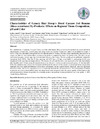Please use this identifier to cite or link to this item:
https://accedacris.ulpgc.es/handle/10553/114252
| DC Field | Value | Language |
|---|---|---|
| dc.contributor.author | Ahmed, Sydia | en_US |
| dc.contributor.author | Navarro Botello, Victor | en_US |
| dc.contributor.author | Jáber Mohamad, José Raduán | en_US |
| dc.contributor.author | Sanjuán Velázquez, Esther | en_US |
| dc.contributor.author | Rodríguez Ponce, Eligia | en_US |
| dc.contributor.author | Rodríguez Ventura, Myriam | en_US |
| dc.date.accessioned | 2022-03-30T06:20:04Z | - |
| dc.date.available | 2022-03-30T06:20:04Z | - |
| dc.date.issued | 2021 | en_US |
| dc.identifier.issn | 1560-8530 | en_US |
| dc.identifier.uri | https://accedacris.ulpgc.es/handle/10553/114252 | - |
| dc.description.abstract | The contributions of replacing rye-grass (Lolium spp.) hay with banana (Musa acuminata) by-products on carcass and tissue characteristics, pH and color, in the Canary hair sheep breed were studied. Twenty-two lambs with an initial live weight of 14.8 ± 2.5 kg were individually housed and fed two different diets for 58 days: The first group (experimental diet) received as forage a mixture of fresh banana (Musa acuminata) by-products composed by leaves and pseudo-stem. The other one got commercial rye-grass (Lolium spp.) hay (conventional diet) as a fiber source. The two groups got an additional commercial concentrate food (CON). After the 58 days growing trial (24.3 kg ± 1.0 kg), seven lambs of each group (n=14) were slaughtered in the experimental slaughterhouse. The muscle, the pH, and the color were measured at the time immediately after slaughter and 24 h later, using the muscles Longissimus thoracis et lumborum and semimembranosus. At that time (after 24 h), the remaining semi-carcass was butchered and dissected for analysis of the carcass's regional and tissue composition. Although there is no significant difference on the tissue composition, carcass regional and the muscle pH, there are significant differences in the color in the Longisimus toracis et lumborum between the two assessed diets. The incorporation of banana by-products in a diet to fatten lambs Canary hair sheep breed would not grossly alter the carcass quality, at least based on the assessed parameters. Banana by-products as a feeding resource can maintain animal productivity and meat quality. | en_US |
| dc.language | eng | en_US |
| dc.relation.ispartof | International Journal of Agriculture and Biology | en_US |
| dc.source | International Journal of Agriculture and Biology [ISSN 1560-8530], n. 26, p. 431-435, (2021) | en_US |
| dc.subject | 3104 Producción Animal | en_US |
| dc.subject.other | Banana by-products | en_US |
| dc.subject.other | Carcass traits | en_US |
| dc.subject.other | Hair sheep | en_US |
| dc.subject.other | Meat quality | en_US |
| dc.subject.other | Pelibuey sheep | en_US |
| dc.title | Characteristics of Canary Hair Sheep's Breed Carcass Fed Banana (Musa acuminate) By-Products: Effects on Regional Tissue Composition, pH and Color | en_US |
| dc.type | info:eu-repo/semantics/Article | en_US |
| dc.type | article | en_US |
| dc.identifier.doi | 10.17957/IJAB/15.1853 | en_US |
| dc.identifier.scopus | 2-s2.0-85115639340 | - |
| dc.contributor.orcid | #NODATA# | - |
| dc.contributor.orcid | #NODATA# | - |
| dc.contributor.orcid | #NODATA# | - |
| dc.contributor.orcid | #NODATA# | - |
| dc.contributor.orcid | #NODATA# | - |
| dc.contributor.orcid | #NODATA# | - |
| dc.description.lastpage | 435 | en_US |
| dc.identifier.issue | 3 | - |
| dc.description.firstpage | 431 | en_US |
| dc.investigacion | Ciencias de la Salud | en_US |
| dc.type2 | Artículo | en_US |
| dc.description.numberofpages | 6 | en_US |
| dc.utils.revision | Sí | en_US |
| dc.identifier.ulpgc | Sí | en_US |
| dc.contributor.buulpgc | BU-VET | en_US |
| dc.description.sjr | 0,232 | - |
| dc.description.sjrq | Q3 | - |
| dc.description.scie | SCIE | - |
| dc.description.miaricds | 9,8 | - |
| item.fulltext | Con texto completo | - |
| item.grantfulltext | open | - |
| crisitem.author.dept | GIR Anatomía Aplicada y Herpetopatología | - |
| crisitem.author.dept | Departamento de Morfología | - |
| crisitem.author.dept | GIR OHAPA (Higiene y Protección Alimentaria) Grupo de Investigación | - |
| crisitem.author.dept | Departamento de Patología Animal, Producción Animal, Bromatología y Tecnología de Los Alimentos | - |
| crisitem.author.dept | GIR IUSA-ONEHEALTH 4. Producción y Biotecnología Animal | - |
| crisitem.author.dept | IU de Sanidad Animal y Seguridad Alimentaria | - |
| crisitem.author.dept | Departamento de Patología Animal, Producción Animal, Bromatología y Tecnología de Los Alimentos | - |
| crisitem.author.dept | GIR IUIBS: Nutrición | - |
| crisitem.author.dept | IU de Investigaciones Biomédicas y Sanitarias | - |
| crisitem.author.dept | Departamento de Patología Animal, Producción Animal, Bromatología y Tecnología de Los Alimentos | - |
| crisitem.author.orcid | 0000-0001-6413-3230 | - |
| crisitem.author.orcid | 0000-0002-4789-8124 | - |
| crisitem.author.orcid | 0000-0002-9174-9708 | - |
| crisitem.author.orcid | 0000-0001-9037-2577 | - |
| crisitem.author.parentorg | Departamento de Morfología | - |
| crisitem.author.parentorg | Departamento de Patología Animal, Producción Animal, Bromatología y Tecnología de Los Alimentos | - |
| crisitem.author.parentorg | IU de Sanidad Animal y Seguridad Alimentaria | - |
| crisitem.author.parentorg | IU de Investigaciones Biomédicas y Sanitarias | - |
| crisitem.author.fullName | Navarro Botello, Victor | - |
| crisitem.author.fullName | Jáber Mohamad, José Raduán | - |
| crisitem.author.fullName | Sanjuán Velázquez, Esther | - |
| crisitem.author.fullName | Rodríguez Ponce, Eligia | - |
| crisitem.author.fullName | Rodríguez Ventura, Myriam | - |
| Appears in Collections: | Artículos | |
Page view(s)
90
checked on Apr 27, 2024
Download(s)
51
checked on Apr 27, 2024
Google ScholarTM
Check
Altmetric
Share
Export metadata
Items in accedaCRIS are protected by copyright, with all rights reserved, unless otherwise indicated.
